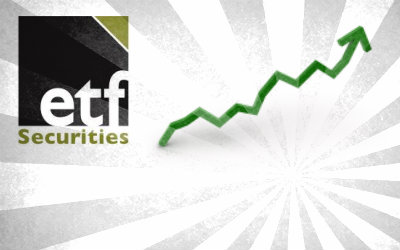Analys
Cyklisk rotation driver rekordstora inflöden till olje-ETPer och utflöden från guld

 Råvaror fortsatte att prestera dåligt under Q4 2014 och året som helhet är det sämsta för tillgångsklassen sedan finanskrisen. En perfekt storm av faktorer – starkt utbud inom de flesta råvarusektorerna, oro över efterfrågan från Kina och en starkare amerikansk dollar – ligger bakom de låga råvarupriserna och att det globala förvaltade kapitalet sjönk till 101,5 miljarder dollar i Q4, en minskning med 9,2 miljarder dollar jämfört med Q3. Nettoflödena till råvaru-ETPer var neutrala och minskningen av förvaltat kapital bestod i sin helhet av prisändringar. Investerarna tycks se det nuvarande läget som ett tillfälle att öka sin exponering mot cykliska råvarutillgångar och rotera bort från mer defensiva exponeringar som guld.
Råvaror fortsatte att prestera dåligt under Q4 2014 och året som helhet är det sämsta för tillgångsklassen sedan finanskrisen. En perfekt storm av faktorer – starkt utbud inom de flesta råvarusektorerna, oro över efterfrågan från Kina och en starkare amerikansk dollar – ligger bakom de låga råvarupriserna och att det globala förvaltade kapitalet sjönk till 101,5 miljarder dollar i Q4, en minskning med 9,2 miljarder dollar jämfört med Q3. Nettoflödena till råvaru-ETPer var neutrala och minskningen av förvaltat kapital bestod i sin helhet av prisändringar. Investerarna tycks se det nuvarande läget som ett tillfälle att öka sin exponering mot cykliska råvarutillgångar och rotera bort från mer defensiva exponeringar som guld.
Det rekordstora inflödet till energisektorn vägde i stort sett upp det stora utflödet från guld-ETPer i Q4 2014 och resultatet blev ett nettoutflöde för råvaru-ETPer på måttliga 30 miljoner dollar. Guld-ETPer hade det största kvartalsutflödet på ett år, totalt 3,1 miljarder dollar, och flödena kom framförallt från amerikanska investerare (78 %) som fått ökat förtroende för USAs återhämtning. Amerikanska investerare drev även det starka inflödet till energi-ETPer och stod för 85 % av det totala inflödet på 3,2 miljarder dollar.
”Investerarna återvänder till råvaror, attraherade av priser som ligger på eller under produktionskostnaden. I det korta perspektivet kan företag och gruvor fortsätta producera trots att priserna ligger under produktionskostnaden, men det är inte hållbart i längden. Om vi inte börjar se en prisuppgång snart kommer produktionen förr eller senare sjunka. Minskat utbud kommer resultera i högre råvarupriser under 2015”, säger Peter Lidblom, Nordenchef på ETF Securities.
Den starka amerikanska dollarn har också bidragit till att dämpa råvarupriserna. Dollarns framfart är dock pådriven av en stark amerikansk ekonomisk tillväxt vilket i grunden är positivt för efterfrågan på råvaror. Samtidigt förväntas beslutsfattare i både Kina och Europa fortsätta reagera starkt på den senaste tidens svaga ekonomiska utveckling i de båda regionerna.
Cykliska råvaror förväntas bli de stora vinnarna av den ekonomiska återhämtningen i USA och Kina under 2015. Kina fortsätter stimulera sin ekonomi och planerar fler råvaruintensiva infrastrukturinvesteringar under 2015 vilket kommer ha en positiv inverkan på de råvaror som är beroende av ekonomisk aktivitet. De bästa investeringsmöjligheterna inför 2015 finns inom cykliska tillgångar givet den tilltagande globala återhämtningen. Men det finns risker, inte minst gällande svagare tillväxt och hot om deflation i Euroområdet och Japan, samt den trögare ekonomiska återhämtningen i Storbritannien. Våra främsta tips inför 2015 är råvarusektorer med exponering mot industrin, som till exempel metaller och energi.
Sammanfattning av de främsta trenderna under 2014:
Förvaltat kapital i råvaru-ETPer sjönk med 20,6 miljarder dollar till 101,5 miljarder dollar i slutet av 2014. En stark amerikansk dollar och oro över tillväxten i Kina och Europa pressade ner många råvarupriser under produktionskostnad.
Taktiska investerare har varit aktiva i råvaror under hela 2014 och investerarnas uthållighet reflekterar den strategiska karaktären hos innehavare av råvaru-ETPer.
Nästan 100 % av nedgången i förvaltat kapital för råvaror under 2014 berodde på prisfall. Nettoutflödet uppgick till måttliga 30 miljoner dollar vilket visar att investerarna verkar rotera in i mer cykliska råvaruexponeringar.
Många råvaror handlas nu på eller under produktionskostnaden. Detta lockar ett antal långsiktiga värdeinvesterare till enskilda råvaror och sektorer där prisnedgången varit särskilt aggressiv.
Ädelmetall-ETPer stod för över 70 % av nedgången i förvaltat kapital för råvaror under 2014. Det förvaltade kapitalet i ädelmetall-ETPer uppgick i slutet av året till 79 miljarder dollar, efter en minskning på 14,8 miljarder dollar under 2014. Utflödena från guld kom huvudsakligen från amerikanska investerare, troligen som ett resultat av mindre defensiva portföljpositioneringar.
Palladium var den enda ädelmetallen som gick mot trenden med ökat förvaltat kapital på 0,9 miljarder dollar. Bakom ökningen låg hotet om utbudsstörningar och en positiv efterfråga vilket höll priserna uppe under 2014. Ökningen i förvaltat kapital bestod till hälften av inflöden.
Guld undantaget hade alla ädelmetaller nettoinflöden under året. Platina och palladium gynnades av potentiella utbudsstörningar i Sydafrika och Ryssland och hade de största inflödena på 432 respektive 376 miljoner dollar.
Energi-ETPer hade starka inflöden under 2014, framförallt under de sista tre månaderna då prisfallet för råolja och naturgas upplevdes överdrivet. Råolja hade den största andelen inflöden medan naturgas stod för runt 25 %. De globala inflödena var mestadels drivna av amerikanska investerare som stod för runt 85 %. Hela inflödet till naturgas kom från amerikanska investerare då stora lager och milt väder tvingade ner priserna på den lägsta nivån sedan 2012.
Näst efter energisektorn hade breda råvaruindex-ETPer de största inflödena (1,1 miljarder dollar) under 2014. Detta indikerar att investerarna börjar se råvaror som en tillgångsklass med högt relativt värde när värderingarna på aktie- och räntemarknaderna skjutit i höjden samtidigt som råvarupriserna gått ner.
Investerarna eftersökte större exponering mot korn, vilket delvis kompenserade utflöden från breda jordbruks-ETPer under 2014. Låga priser på majs och vete attraherade långsiktiga investerare som tror att odlingsförhållandena sannolikt inte kommer vara lika goda den här säsongen som förra. Kaffe hade det största utflödet eftersom möjligheten att El-Nino inträffar under 2015 skulle kunna öka utbudet.
Industrimetaller hade blandade flöden och slutade året med ett utflöde på måttliga 2 miljoner dollar. Problem på utbudssidan gjorde att nickel hade inflöden under varje kvartal under 2014, totalt 122 miljoner dollar. Oro över Kinesisk efterfrågan och ökad finansieringsrisk fick investerarna att dra sig ur koppar-ETPer (52 miljoner dollar). Diversifierade industrimetaller och zink-ETPer hade också utflöden.
Analys
Tightening fundamentals – bullish inventories from DOE

The latest weekly report from the US DOE showed a substantial drawdown across key petroleum categories, adding more upside potential to the fundamental picture.

Commercial crude inventories (excl. SPR) fell by 5.8 million barrels, bringing total inventories down to 415.1 million barrels. Now sitting 11% below the five-year seasonal norm and placed in the lowest 2015-2022 range (see picture below).
Product inventories also tightened further last week. Gasoline inventories declined by 2.1 million barrels, with reductions seen in both finished gasoline and blending components. Current gasoline levels are about 3% below the five-year average for this time of year.
Among products, the most notable move came in diesel, where inventories dropped by almost 4.1 million barrels, deepening the deficit to around 20% below seasonal norms – continuing to underscore the persistent supply tightness in diesel markets.
The only area of inventory growth was in propane/propylene, which posted a significant 5.1-million-barrel build and now stands 9% above the five-year average.
Total commercial petroleum inventories (crude plus refined products) declined by 4.2 million barrels on the week, reinforcing the overall tightening of US crude and products.


Analys
Bombs to ”ceasefire” in hours – Brent below $70

A classic case of “buy the rumor, sell the news” played out in oil markets, as Brent crude has dropped sharply – down nearly USD 10 per barrel since yesterday evening – following Iran’s retaliatory strike on a U.S. air base in Qatar. The immediate reaction was: “That was it?” The strike followed a carefully calibrated, non-escalatory playbook, avoiding direct threats to energy infrastructure or disruption of shipping through the Strait of Hormuz – thus calming worst-case fears.

After Monday morning’s sharp spike to USD 81.4 per barrel, triggered by the U.S. bombing of Iranian nuclear facilities, oil prices drifted sideways in anticipation of a potential Iranian response. That response came with advance warning and caused limited physical damage. Early this morning, both the U.S. President and Iranian state media announced a ceasefire, effectively placing a lid on the immediate conflict risk – at least for now.
As a result, Brent crude has now fallen by a total of USD 12 from Monday’s peak, currently trading around USD 69 per barrel.
Looking beyond geopolitics, the market will now shift its focus to the upcoming OPEC+ meeting in early July. Saudi Arabia’s decision to increase output earlier this year – despite falling prices – has drawn renewed attention considering recent developments. Some suggest this was a response to U.S. pressure to offset potential Iranian supply losses.
However, consensus is that the move was driven more by internal OPEC+ dynamics. After years of curbing production to support prices, Riyadh had grown frustrated with quota-busting by several members (notably Kazakhstan). With Saudi Arabia cutting up to 2 million barrels per day – roughly 2% of global supply – returns were diminishing, and the risk of losing market share was rising. The production increase is widely seen as an effort to reassert leadership and restore discipline within the group.
That said, the FT recently stated that, the Saudis remain wary of past missteps. In 2018, Riyadh ramped up output at Trump’s request ahead of Iran sanctions, only to see prices collapse when the U.S. granted broad waivers – triggering oversupply. Officials have reportedly made it clear they don’t intend to repeat that mistake.
The recent visit by President Trump to Saudi Arabia, which included agreements on AI, defense, and nuclear cooperation, suggests a broader strategic alignment. This has fueled speculation about a quiet “pump-for-politics” deal behind recent production moves.
Looking ahead, oil prices have now retraced the entire rally sparked by the June 13 Israel–Iran escalation. This retreat provides more political and policy space for both the U.S. and Saudi Arabia. Specifically, it makes it easier for Riyadh to scale back its three recent production hikes of 411,000 barrels each, potentially returning to more moderate increases of 137,000 barrels for August and September.
In short: with no major loss of Iranian supply to the market, OPEC+ – led by Saudi Arabia – no longer needs to compensate for a disruption that hasn’t materialized, especially not to please the U.S. at the cost of its own market strategy. As the Saudis themselves have signaled, they are unlikely to repeat previous mistakes.
Conclusion: With Brent now in the high USD 60s, buying oil looks fundamentally justified. The geopolitical premium has deflated, but tensions between Israel and Iran remain unresolved – and the risk of missteps and renewed escalation still lingers. In fact, even this morning, reports have emerged of renewed missile fire despite the declared “truce.” The path forward may be calmer – but it is far from stable.
Analys
A muted price reaction. Market looks relaxed, but it is still on edge waiting for what Iran will do

Brent crossed the 80-line this morning but quickly fell back assigning limited probability for Iran choosing to close the Strait of Hormuz. Brent traded in a range of USD 70.56 – 79.04/b last week as the market fluctuated between ”Iran wants a deal” and ”US is about to attack Iran”. At the end of the week though, Donald Trump managed to convince markets (and probably also Iran) that he would make a decision within two weeks. I.e. no imminent attack. Previously when when he has talked about ”making a decision within two weeks” he has often ended up doing nothing in the end. The oil market relaxed as a result and the week ended at USD 77.01/b which is just USD 6/b above the year to date average of USD 71/b.

Brent jumped to USD 81.4/b this morning, the highest since mid-January, but then quickly fell back to a current price of USD 78.2/b which is only up 1.5% versus the close on Friday. As such the market is pricing a fairly low probability that Iran will actually close the Strait of Hormuz. Probably because it will hurt Iranian oil exports as well as the global oil market.
It was however all smoke and mirrors. Deception. The US attacked Iran on Saturday. The attack involved 125 warplanes, submarines and surface warships and 14 bunker buster bombs were dropped on Iranian nuclear sites including Fordow, Natanz and Isfahan. In response the Iranian Parliament voted in support of closing the Strait of Hormuz where some 17 mb of crude and products is transported to the global market every day plus significant volumes of LNG. This is however merely an advise to the Supreme leader Ayatollah Ali Khamenei and the Supreme National Security Council which sits with the final and actual decision.
No supply of oil is lost yet. It is about the risk of Iran closing the Strait of Hormuz or not. So far not a single drop of oil supply has been lost to the global market. The price at the moment is all about the assessed risk of loss of supply. Will Iran choose to choke of the Strait of Hormuz or not? That is the big question. It would be painful for US consumers, for Donald Trump’s voter base, for the global economy but also for Iran and its population which relies on oil exports and income from selling oil out of that Strait as well. As such it is not a no-brainer choice for Iran to close the Strait for oil exports. And looking at the il price this morning it is clear that the oil market doesn’t assign a very high probability of it happening. It is however probably well within the capability of Iran to close the Strait off with rockets, mines, air-drones and possibly sea-drones. Just look at how Ukraine has been able to control and damage the Russian Black Sea fleet.
What to do about the highly enriched uranium which has gone missing? While the US and Israel can celebrate their destruction of Iranian nuclear facilities they are also scratching their heads over what to do with the lost Iranian nuclear material. Iran had 408 kg of highly enriched uranium (IAEA). Almost weapons grade. Enough for some 10 nuclear warheads. It seems to have been transported out of Fordow before the attack this weekend.
The market is still on edge. USD 80-something/b seems sensible while we wait. The oil market reaction to this weekend’s events is very muted so far. The market is still on edge awaiting what Iran will do. Because Iran will do something. But what and when? An oil price of 80-something seems like a sensible level until something do happen.
-

 Nyheter4 veckor sedan
Nyheter4 veckor sedanUppgången i oljepriset planade ut under helgen
-

 Nyheter3 veckor sedan
Nyheter3 veckor sedanMahvie Minerals växlar spår – satsar fullt ut på guld
-

 Nyheter4 veckor sedan
Nyheter4 veckor sedanLåga elpriser i sommar – men mellersta Sverige får en ökning
-

 Nyheter2 veckor sedan
Nyheter2 veckor sedanOljan, guldet och marknadens oroande tystnad
-

 Nyheter2 veckor sedan
Nyheter2 veckor sedanJonas Lindvall är tillbaka med ett nytt oljebolag, Perthro, som ska börsnoteras
-

 Analys4 veckor sedan
Analys4 veckor sedanVery relaxed at USD 75/b. Risk barometer will likely fluctuate to higher levels with Brent into the 80ies or higher coming 2-3 weeks
-

 Analys3 veckor sedan
Analys3 veckor sedanA muted price reaction. Market looks relaxed, but it is still on edge waiting for what Iran will do
-

 Nyheter2 veckor sedan
Nyheter2 veckor sedanDomstolen ger klartecken till Lappland Guldprospektering












